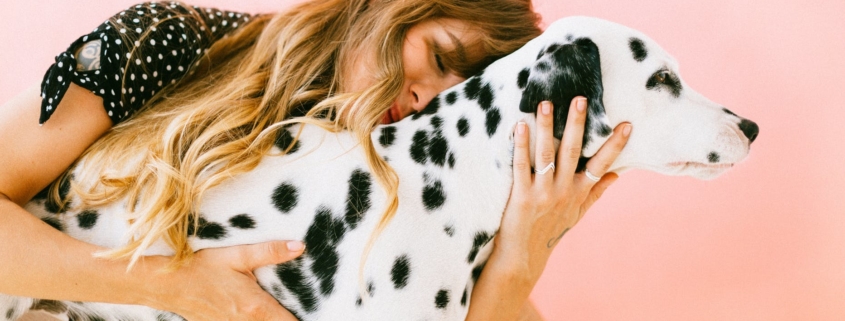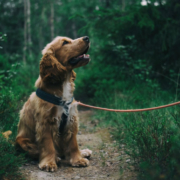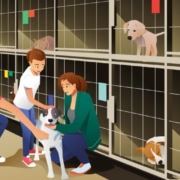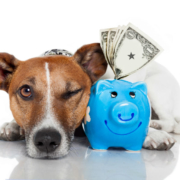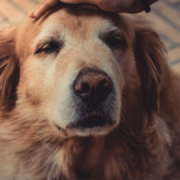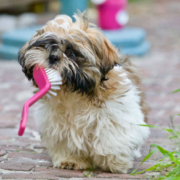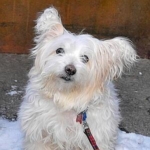Any dog owner knows that one of the simple facts of life for dogs is that they love toys, and they’ll be more than happy to turn everyday objects, such as shoes and remote controls, into toys should the need arise. Shopping for dog toys seems easy enough, as dogs are easily entertained, but after a spate of scandals involving toys made in China and mis-use of dog toys, safety when choosing dog toys and clothes should be a major concern for dog owners.
Toys
Dog toys keep your dog active, healthy, and stress-free. For a dog, a life without toys is boring and stressful. According to the Humane Society, dog toys fall under three distinct categories, each with a different purpose when used by your dog. These categories are: active toys, distraction toys, and comfort toys.
Active toys are those that allow your dog to exercise and work off pent-up energy. Active toys may include hard rubber balls, play ropes, and other interactive play toys you can share with your dog, such as a flying disk or tennis ball. Active toys give your dog the short-burst exercise she needs beyond walking and running. These types of toys are also important for both you and your dog, as they help you to share and maintain a bond.
Safety considerations that you must take when purchasing active toys include the following:
- Pick out toys that are appropriate for your dog’s size. Smaller balls and ropes should be used with smaller dogs, while larger balls and ropes should be used with larger dogs. Mis-matching toy sizes, especially for active toys such as balls and ropes, can lead to choking hazards.
- Buy quality toys made of durable materials for your dog. If you notice excessive wear on any of your dog’s toys, the toy should be discarded and replaced.
- Dog-proof your home and yard by removing or securing any items that may be hazardous to your dog. Items such as string, ribbon, rubber bands, pantyhose, and any other soft, apparently edible materials fall under this category.
Distraction toys, such as bones and other chew toys, are toys that allow your dog to expend energy with apparently “mindless” chewing and kneading. Distraction toys are often filled with treats or have a chamber in which you can insert your own treats for your dog. These types of toys are usually used by your dog on her own, and special safety considerations should be made when purchasing these toys.
- Distraction toys should not have any movable parts, and chambers that may be filled with treats should be fairly easily accessed by your dog, otherwise she will destroy the toy creating a mess of choking hazards in your yard or on the floors of your home.
- Size considerations – matching small toys to small dogs, large toys to large dogs – are also important when choosing distraction toys.
- Distraction toys may suggest you provide treats and other edible items within the toy for your dog. Only use treats you know your dog can healthily digest with distraction toys.
- Rawhide is commonly associated with chew toys, but should be avoided unless cleared by your veterinarian. Rawhide presents a potential choking hazard to most dogs, and is also inhumanely produced. When choosing toys, quality toys made of durable materials such as hard rubber are usually a better option than rawhide.
Comfort toys are a category of toys that your dog will treat with care, like a baby. Remember your favorite stuffed animal or “blankie?” Comfort toys serve a similar purpose to your dog as these relics of childhood did for you at a young age. These toys are usually smaller and softer than active and distraction toys, and as such may not be appropriate for larger dogs. In some cases, your dog will present schizophrenic behavior with her comfort toy – she may shake and “kill” the same toy that she normally likes to care for and “baby.” This behavior is normal for most dogs, but it can present serious problems if the toy is unable to withstand the abuse.
- Comfort toys should match your dog’s size, and should be both soft and durable, with no moving parts or stray materials that can be potential choking hazards.
- Your T-shirts and socks may be treated as comfort toys by your dog due to the familiar smell and texture, but you should discourage this behavior, as these items may prevent serious choking hazards if torn or shredded by your dog. Hide a quality, durable comfort toy in your home for your dog to find, and she’ll cherish her “find” forever.
- If your dog’s behavior towards her comfort toy becomes erratic or strange beyond an occasional “kill,” remove the toy and consult your veterinarian. Comfort toys may need to be replaced or presented in cycles for your dog to fully appreciate them.
Made in China
Scandals involving dog toys made in China have presented a great opportunity for dog owners to choose safer, healthier toys made in the U.S.A. Always opt for quality, durable materials when shopping for dog toys, and avoid synthetics when possible.
Dog Clothes
Clothes for dogs are considered a guilty pleasure by some, but in fact they are a fun way to provide comfort and safety to your dog when used appropriately.
- Dog clothes should never, ever be used as a “gimmick” or for the purpose of ridicule. You can severely damage your dog’s psyche and behavior by dressing her up and then laughing at her. Think twice before sticking that silly Cosby sweater on your dog – are you doing it to protect your dog from the cold, or just for a laugh? If you answer the latter, ask yourself this: is a bit of laughter worth wiping out several months of training?
- Never allow your dog to wear dog clothes unsupervised. Other dogs may want to tug at your dog’s clothes, causing injuries, and your dog may get snagged or choke on its clothes. Avoid clothes with stray parts, such as straps or ties, that may attract bites and tugs from other dogs or your own.
- Comfort is key: size your dog yourself, or have your dog fitted at a doggie boutique. Dog clothes that are too tight may constrict your dog’s breathing or digestive functions, while dog clothes that are too loose may be easier to snag or be attacked by other dogs. Never buy dog clothes that constrict your dog’s movement. Sleeves should not reach past the joints, and clothes should be loose at the neck and rib cage.
- Make sure your dog’s clothes are made of durable material that won’t shrink or skew after washings.
- Buy dog clothes that are climate appropriate. Don’t over- or under-dress your dog for the conditions. Doggie jackets are a great option for cooler weather, while lighter, breathable materials are great for the sunnier warmer months. As tempting as it may be, shades and sunglasses are not recommended for dogs.
Proper use of dog toys and clothes will round out your dog’s quality of life. Dressing your dog appropriately and providing her with a stock of safe and durable active, distraction, and comfort toys will benefit your bond with your dog and benefit your dog with comfort and exercise.

